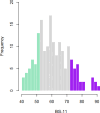Functional Brain Network of Trait Impulsivity: Whole-Brain Functional Connectivity Predicts Self-Reported Impulsivity
- PMID: 39469891
- PMCID: PMC11519747
- DOI: 10.1002/hbm.70059
Functional Brain Network of Trait Impulsivity: Whole-Brain Functional Connectivity Predicts Self-Reported Impulsivity
Abstract
Given impulsivity's multidimensional nature and its implications across various aspects of human behavior, a comprehensive understanding of functional brain circuits associated with this trait is warranted. In the current study, we utilized whole-brain resting-state functional connectivity data of healthy males (n = 156) to identify a network of connections predictive of an individual's impulsivity, as assessed by the Barratt Impulsiveness Scale (BIS)-11. Our participants were selected, in part, based on their self-reported BIS-11 impulsivity scores. Specifically, individuals who reported high or low trait impulsivity scores during screening were selected first, followed by those with intermediate impulsivity levels. This enabled us to include participants with rare, extreme scores and to cover the entire BIS-11 impulsivity spectrum. We employed repeated K-fold cross-validation for feature-selection and used stratified 10-fold cross-validation to train and test our models. Our findings revealed a widespread neural network associated with trait impulsivity and a notable correlation between predicted and observed scores. Feature importance and node degree were assessed to highlight specific nodes and edges within the impulsivity network, revealing previously overlooked key brain regions, such as the cerebellum, brainstem, and temporal lobe, while supporting previous findings on the basal ganglia-thalamo-prefrontal network and the prefrontal-motor strip network in relation to impulsiveness. This deepened understanding establishes a foundation for identifying alterations in functional brain networks associated with dysfunctional impulsivity.
Keywords: impulsivity; individual differences; machine learning; resting‐state functional connectivity.
© 2024 The Author(s). Human Brain Mapping published by Wiley Periodicals LLC.
Conflict of interest statement
The authors declare no conflicts of interest.
Figures






Similar articles
-
Intrinsic Network Connectivity Patterns Underlying Specific Dimensions of Impulsiveness in Healthy Young Adults.Brain Topogr. 2018 May;31(3):477-487. doi: 10.1007/s10548-017-0604-9. Epub 2017 Nov 3. Brain Topogr. 2018. PMID: 29101492
-
Neurobiological correlates of impulsivity in healthy adults: Lower prefrontal gray matter volume and spontaneous eye-blink rate but greater resting-state functional connectivity in basal ganglia-thalamo-cortical circuitry.Neuroimage. 2017 Aug 15;157:288-296. doi: 10.1016/j.neuroimage.2017.06.015. Epub 2017 Jun 8. Neuroimage. 2017. PMID: 28602816 Free PMC article.
-
Brain functional connectome-based prediction of individual decision impulsivity.Cortex. 2020 Apr;125:288-298. doi: 10.1016/j.cortex.2020.01.022. Epub 2020 Feb 11. Cortex. 2020. PMID: 32113043
-
You do not have to act to be impulsive: Brain resting-state activity predicts performance and impulsivity on the Balloon Analogue Risk Task.Behav Brain Res. 2020 Feb 3;379:112395. doi: 10.1016/j.bbr.2019.112395. Epub 2019 Nov 28. Behav Brain Res. 2020. PMID: 31786275
-
Reward and executive control network resting-state functional connectivity is associated with impulsivity during reward-based decision making for cocaine users.Drug Alcohol Depend. 2019 Jan 1;194:32-39. doi: 10.1016/j.drugalcdep.2018.09.013. Epub 2018 Oct 24. Drug Alcohol Depend. 2019. PMID: 30391836 Free PMC article.
Cited by
-
Resting-State Sensory-Motor Connectivity between Hand and Mouth as a Neural Marker of Socioeconomic Disadvantage, Psychosocial Stress, Cognitive Difficulties, Impulsivity, Depression, and Substance Use in Children.J Cell Neurosci. 2025;2(1):31-46. doi: 10.31586/jcn.2025.1280. Epub 2025 Mar 25. J Cell Neurosci. 2025. PMID: 40230597 Free PMC article.
-
Impact of impulsivity on the relationship of the brain structures with school performance.NPJ Sci Learn. 2025 Aug 8;10(1):51. doi: 10.1038/s41539-025-00344-z. NPJ Sci Learn. 2025. PMID: 40781083 Free PMC article.
References
-
- Abdallah, M. , Farrugia N., Chirokoff V., and Chanraud S.. 2020. “Static and Dynamic Aspects of Cerebro‐Cerebellar Functional Connectivity Are Associated With Self‐Reported Measures of Impulsivity: A Resting‐State fMRI Study.” Network Neuroscience 4, no. 3: 891–909. 10.1162/netn_a_00149. - DOI - PMC - PubMed
MeSH terms
Grants and funding
LinkOut - more resources
Full Text Sources
Medical
Miscellaneous

